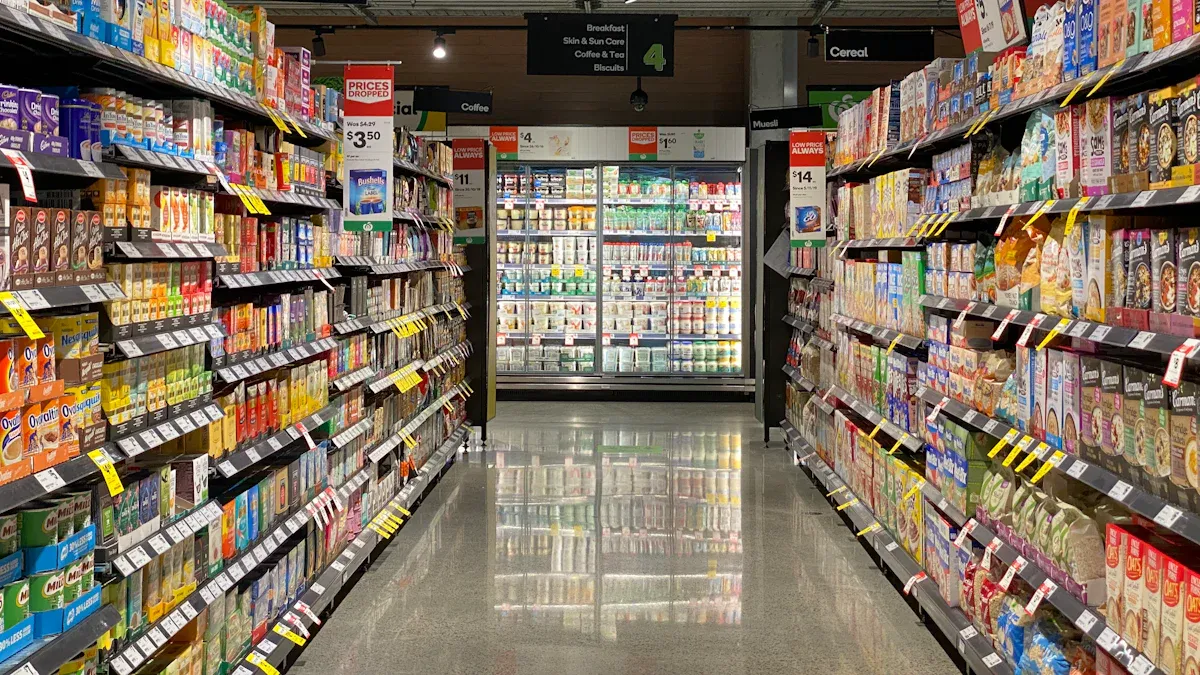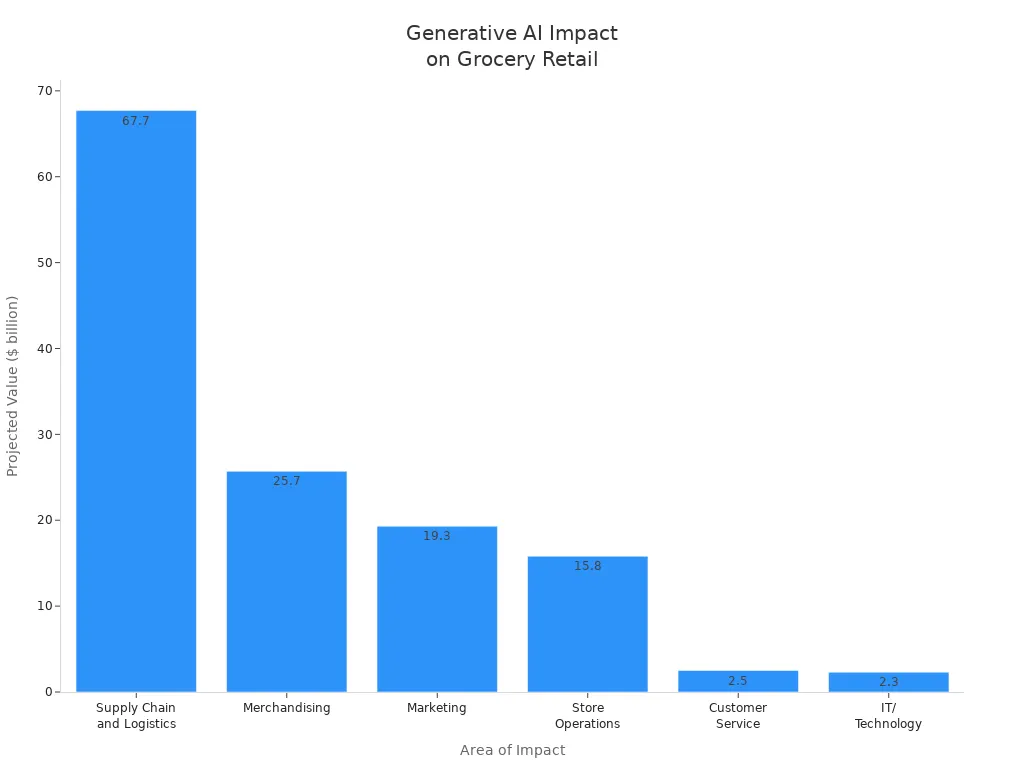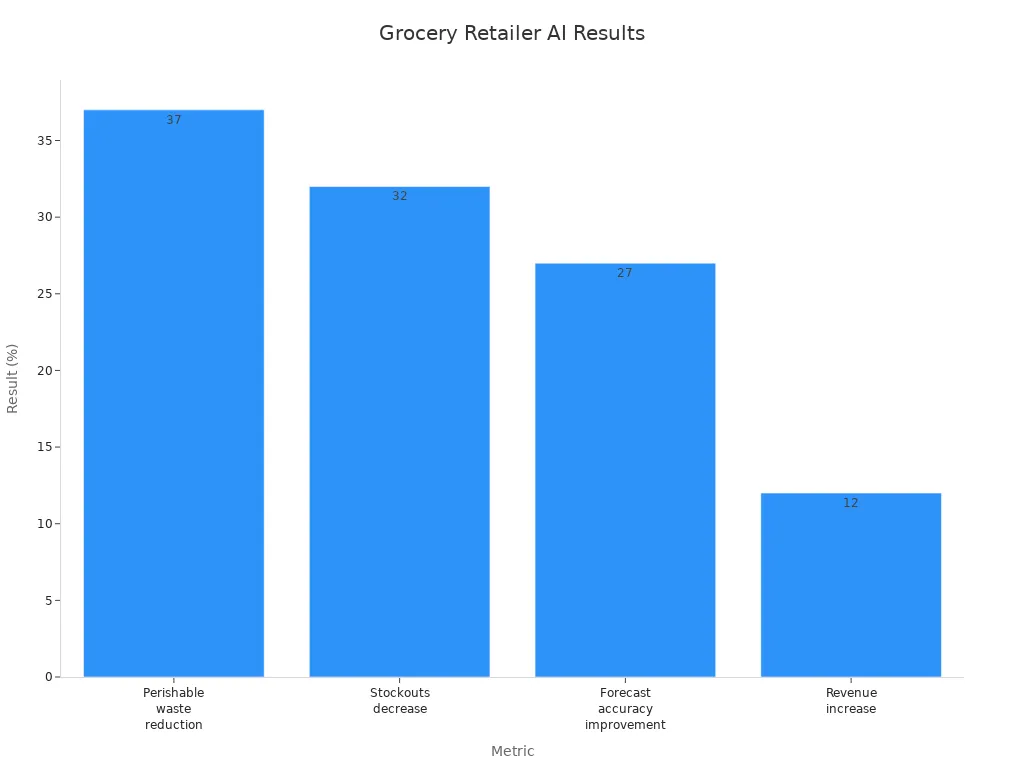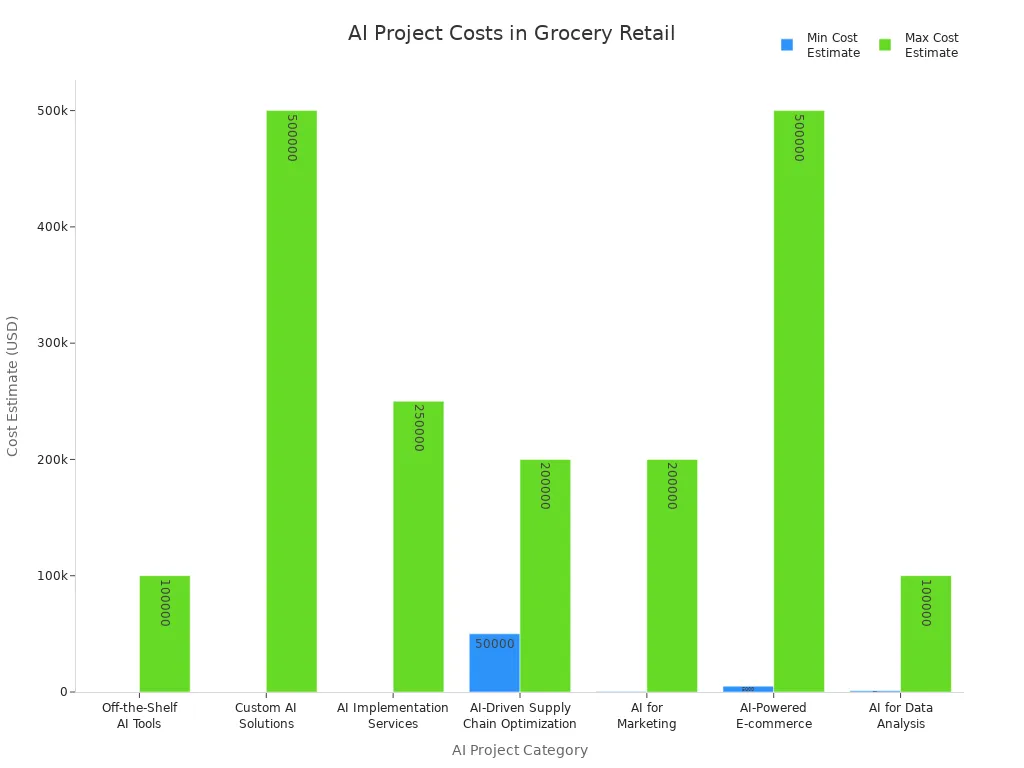AI Retail Transformation in Grocery: What’s Next

AI retail transformation in grocery is accelerating. Generative AI, omnichannel shopping, and dual transformation are leading this new phase. Grocery stores are leveraging AI to streamline operations and enhance customer service. The global market for AI in grocery retail was valued at $5.3 billion in 2024, with experts predicting a growth rate of 27.8% annually. By 2033, the market could reach $51.7 billion.
Metric | Value |
|---|---|
Market Size in 2024 | USD 5.3 billion |
Projected CAGR | 27.8% |
Forecasted Market Size by 2033 | USD 51.7 billion |

Generative AI will transform supply chains, merchandising, marketing, and in-store operations. Technology spending may increase by 12 times by 2030. Grocery leaders are focusing on AI retail transformation to improve efficiency and maintain a competitive edge. They believe that embracing AI is essential for future competitiveness. Understanding AI adoption will prepare stores for innovative business practices.
AI-powered solutions will enhance the shopping experience, fostering customer loyalty and satisfaction.
Key Takeaways
AI is changing grocery stores by making work faster and better for shoppers. Using AI is important to keep up with other stores. Grocery stores go through three steps with AI: making jobs easier, changing what workers do, and creating new ways to run the store. Each step gives stores new chances to grow. AI lets stores use new ways to sell things. This helps them reach more people and get bigger orders. Stores can make more money and make customers happier. AI helps stores send special ads to each shopper. These ads and tips make people want to shop again. Spending money on AI can help stores save a lot and manage their stock better. Stores can waste less and earn more by using AI to help them decide what to buy and sell.
Phases of AI Retail Transformation
Grocery stores are going through three big phases of ai retail transformation. Each phase brings new chances and changes for how stores work and how customers shop.
Exploring New Business Models
Retailers start with the optimizer phase. In this phase, they use ai to make certain jobs easier and faster. For example, ai-driven demand forecasting helps stores know what products people will buy. This helps stores waste less and keep shelves stocked. Personalized marketing uses ai to make special ads and suggest products to shoppers. Cashierless checkout systems use ai and computer vision so people can pay without waiting in line. Ai agents help customers plan meals and manage their budgets. This makes shopping simpler and more personal.
Phase | Description |
|---|---|
Optimizer | Focus on efficiency through AI for discrete tasks; limited organizational impact. |
Transformer | AI begins to redefine roles and capabilities; requires investment in workforce upskilling and governance structures. |
Reinventor | Complete reimagining of operating models; embedding AI in decision-making for innovation and growth. |
In the transformer phase, ai retail transformation starts to change how stores run. Ai begins to change jobs and what workers do. Employees need to learn new skills, so companies train them and set up new rules. Ai agents do shopping tasks, which changes how customers shop.
The reinventor phase is a total change. Retailers use ai to help make big decisions and build new ways to do business. Ai helps stores come up with new ideas and grow. Stores offer things like autonomous shopping and smarter product suggestions.
Ai retail transformation lets stores give special services, work better, and make shopping more personal.
Adopting New Sales Channels
Ai retail transformation helps grocery stores find new ways to sell. Retailers use ai to study customer data and spot ways to grow. For example, ai shows there is an 8% chance for more sales in grocery e-commerce. Many online shoppers have never been inside a store. Online shopping baskets are three times bigger than in-store baskets. Omnichannel shoppers spend 15% more, so smart strategies work well.
Ai helps stores reach new customers online.
Stores use ai to make shopping easy in stores and online.
Ai retail transformation helps stores get bigger baskets and more sales.
Stores that use ai-powered sales channels make more money and keep customers happy. Ai helps stores give special deals and make shopping easier for everyone.
Evolving Ways of Working
Ai retail transformation changes how workers do their jobs in grocery stores. Ai does boring tasks, so staff can help customers and solve problems in new ways. Computer vision lets stores watch what happens almost instantly and automates up to 90% of simple jobs. Workers spend more time with shoppers, which makes work better and helps customers more.
As ai does more simple work, people do more planning and creative jobs. Stores need to teach workers new skills and change how work gets done. Employees and ai work together as a team. This change makes work more fun and helps customers get better service.
Predictive staffing uses behavior patterns to put workers where needed.
Mapping each customer’s journey helps stores set up products better.
Precision service optimization finds slow spots and speeds up service.
Advanced merchandising uses movement data to find new ways to sell.
Ai retail transformation makes stores work better and helps customers have a good experience. Stores respond faster to what shoppers want and make shopping more welcoming.
Current State of Grocery Retail AI

Real-Time Data and Predictive Models
Ai in grocery is getting better every year. Stores use real-time data and predictive models to make smarter choices. Corporation Favorita looks at old sales numbers and outside factors. They use this information to guess future sales, manage inventory, and plan marketing. Ai-powered insights help stores see patterns and change quickly. Retailers use predictive analytics to guess what customers will want. This helps them keep the right amount of products and run smart promotions. By using both old and new data, stores can change plans based on what shoppers do. This makes stores work better and helps them grow.
Predictive analytics helps stores react to market changes.
Optimization stops stores from running out or having too much stock.
Ai-powered insights help stores pick the best promotions.
Inventory Optimization and Waste Reduction
Grocery stores have problems with food that goes bad and keeping track of stock. Ai in grocery helps a lot with inventory and waste. OrderGrid’s AI Demand Forecasting helped one store waste 37% less food and have 32% fewer stockouts. Forecasts got 27% more accurate, and revenue went up by 12%. These results show how strong ai-powered insights are for grocery stores.
Metric | Result |
|---|---|
Perishable waste reduction | 37% |
Stockouts decrease | 32% |
Forecast accuracy improvement | 27% |
Revenue increase | 12% |

This product helps retail teams handle all expiring inventory, clear out old products fast, and keep food safe.
Optimization helps stores be greener and make more money.
Ai-powered insights cut down on spoiled food and help stores guess demand.
Omnichannel Shopping Experiences
Ai in grocery has changed how people shop in stores and online. Grocery stores now mix online and in-person shopping. This makes it easy for customers to switch between ways to shop. Shoppers want stores to know what they like everywhere. Ai-powered insights make shopping personal and help stores work faster. Retailers use ai to stay ahead and give shoppers what they want.
Grocery shoppers can shop online or in stores easily.
Ai makes customers happier with special services.
Optimization helps stores keep the right products for shoppers.
Automation makes shopping faster and easier.
Ai and machine learning will make grocery shopping even more personal and easy in the future.
Emerging AI Innovations

Generative AI in Content and Product Development
Generative AI is changing how stores make content and products. Companies use AI to make ads and marketing materials fast. They test different ads and pages to find what works best. Target used generative AI for product suggestions and landing pages. This led to a 40% jump in conversion rates. Retailers also use AI to make clear product images. These images help shoppers pick what to buy. Almost half of online shoppers say images help them choose.
Retailers save time and money with generative AI. They spend 35% less on making creative work for seasonal sales. AI-made product bundles have raised average order values by 27%. Target’s system builds bundles that match what customers want. This helps stores sell more and makes shoppers happier.
AI helps test and improve ads and landing pages.
AI-made bundles and images help stores sell more.
Generative AI gives stores new ways to connect with shoppers and make shopping better.
Automated Checkout and Store Operations
Automated checkout systems are now common in grocery stores. These systems use AI and computer vision to let shoppers pay without waiting. Amazon Go uses this technology for cashier-less shopping. Walmart and Aldi use AI in their self-checkout kiosks too. These changes make shopping quicker and easier for everyone.
Impact Area | Description |
|---|---|
Speed Impact | Fast self-checkout makes customers feel service is better. |
Technology Usability | Easy-to-use systems keep customers happy. |
Queue Reduction | Shorter lines mean faster shopping and better experiences. |
Customer Autonomy | |
Loyalty Impact | Some shoppers feel less loyal when buying lots through self-checkout. |
Automated checkout helps stores manage inventory better. Real-time data shows what sells and when. This helps stores keep shelves full and avoid running out. AI-driven inventory management helps stores guess demand and cut waste.
Stores use AI to guess what shoppers will buy.
Natural language lets workers ask about sales and inventory easily.
AI-driven inventory management cuts waste and keeps stock levels right.
Personalized Marketing and Recommendations
AI-driven personalization is changing how stores talk to shoppers. AI looks at shopping patterns and suggests products for each customer. Amazon uses AI to recommend products based on past buys. This has helped stores sell more and made shopping more fun.
Personalized marketing uses AI to send special offers to the right shoppers. These messages help stores keep customers coming back. AI also helps make loyalty rewards that fit each shopper’s habits. This leads to more customers staying and being happy.
Personalization makes shopping more fun and interesting.
AI-driven suggestions help stores sell more and get more conversions.
Special experiences make shoppers want to come back and buy again.
AI in grocery retail helps stores build stronger bonds with customers through personalized marketing and recommendations.
AI Benefits for Grocery Retail
Efficiency and Cost Savings
Retailers notice big improvements in how they work and save money after using ai. Grocery stores say that cutting fresh food waste by 20% with ai forecasting can save $10-20 million every year. Ai pricing tools help stores sell 5-15% more fresh food. If a grocery store makes $5 billion a year, this could mean up to $150 million more profit. Ai lets teams automate simple jobs, so work gets done faster and costs less. Stores use ai to make better choices and react quickly to changes.
Ai forecasting helps stores waste less and save money.
Pricing tools help stores make more profit.
Automation makes work easier and cuts down on manual tasks.
Enhanced Customer Engagement
Ai gives stores new ways to reach customers. Data analysis helps teams learn what shoppers like and how they buy things. Stores use this to make marketing plans that fit each customer. Personalization makes shoppers feel important and keeps them coming back. When stores use ai-driven personalization, they see more people get involved. Customers like getting special offers and better service, which makes shopping nicer.
Metric | Impact on Customer Engagement |
|---|---|
Reduced Waste | More products on shelves, so shoppers are happier |
Improved Margins | Better prices bring in more customers |
Enhanced Customer Loyalty | Personalized service builds trust and repeat visits |
Ai data analysis helps stores know what customers want.
Special marketing makes shoppers happier.
Improved Inventory and Pricing Management
Stores use ai to manage inventory and prices better. Ai looks at old sales and seasonal trends to keep shelves full. This means fewer empty spots and less wasted food. Automation helps teams work faster and use resources better. Dynamic pricing changes prices based on what is happening right now, so stores make more money. Good demand forecasting matches prices to what shoppers want, especially when stores are busy.
Improvement Type | Description |
|---|---|
Inventory Management | Ai automation lowers labor costs and makes warehouses work better. |
Dynamic Pricing | Prices change with real-time info, so stores earn more. |
Demand Forecasting | Good forecasts set prices that shoppers expect during busy times. |
Operational Efficiency | Automating simple jobs saves money and uses resources well. |
Ai helps stores keep shelves full and waste less food.
Automation lets teams react fast to changes in the market.
Dynamic pricing and forecasting help stores earn more and make shoppers happy.
Challenges and Considerations
Data Privacy and Security
Grocery stores have more worries about data privacy now. People are concerned about how stores use their personal information. Some ai tools can find out who someone is with little data. Buying habits can show private things about a person. Stores need strong security and clear rules to keep trust.
Using ai-driven surveillance in stores brings up ethical concerns. Stores must balance safety and privacy to follow laws and keep loyal customers.
Customers want to know how stores use their data.
Stores should update security rules often.
Keeping private information safe is very important.
Implementation Costs and ROI
Using ai in grocery stores costs different amounts. Simple tools like chatbots cost less money. Custom systems need bigger investments. Stores must think about both starting costs and upkeep. The chart below shows the lowest and highest costs for ai projects.

Category | Examples | Cost Range | Best For |
|---|---|---|---|
Off-the-Shelf AI Tools | Chatbots, recommendation engines | $50–$300/month (basic), $10,000–$100,000/year (advanced) | Small to medium-sized retailers |
Custom AI Solutions | Recommendation engines, predictive analytics | $50,000–$500,000+ (development), 15–20% maintenance annually | Large retailers with specific needs |
AI Implementation Services | IBM Watson, Google AI | $50,000–$250,000 (integration), $1,000–$50,000/month (usage) | Retailers needing end-to-end support |
Stores check success by looking at how well things run, how happy customers are, money earned, marketing results, worker productivity, and fewer mistakes.
Workforce Adaptation
Ai systems are changing jobs in grocery stores. Stores use ai tools to guess how many workers they need. These tools also help match jobs to what workers like. This helps keep workers longer and gives better service. Many stores teach workers new skills for jobs that need people, like helping customers and picking products.
Training for customer service jobs
Skills for picking products
Managing prepared food sections
Stores need to keep training workers so they can use new technology.
Ethical and Regulatory Issues
Ethical and legal rules affect how ai works in grocery stores. Stores must stop bias in ai and make choices clear. They need to manage data well and protect privacy. Following laws like GDPR and CCPA keeps stores out of trouble.
Collecting data the right way and getting consent
Stopping bias in ai systems
Making sure automation has clear rules
Stores should think about long-term effects and find ways that help both shoppers and the community.
Preparing for the Future of AI in Grocery Retail
Actionable Steps for Retailers
Grocery retailers can find new chances by planning ahead. They should set business goals first and pick tools that fit these goals. Good data management keeps information safe and ready to use. Hiring people with tech skills helps build strong solutions for the future. Retailers need to choose partners and tools after looking at them closely. Security and following rules are important to keep customer trust.
Retailers often start with small test projects before spending a lot. Teams should focus on what customers want to make shopping better. Making work easier helps stores add new technology faster. Using data helps teams make smart choices and find ways to grow. Learning all the time helps everyone keep up as technology changes.
Set goals and pick tools that fit your needs.
Keep data safe and easy to use.
Build a team with tech experts.
Pick partners and tools carefully.
Protect customer information.
Try new ideas with small test projects.
Focus on what customers want.
Make work simple and efficient.
Use data to make smart choices.
Keep learning about new technology.
Building a Future-Ready AI Strategy
A good plan helps retailers find more chances and stay ahead. Personalization lets stores give shopping experiences that fit each shopper. Predictive inventory management keeps shelves full and cuts waste. Real-time pricing helps shoppers trust stores. Supply chain analytics make work faster and greener.
Stores can use technology to help workers do better and learn new things. Unified commerce platforms make shopping smooth everywhere. AI-powered customer service tools make talking to stores easier. Being quick helps teams handle changes fast. The best tools work when they match clear needs. Customer trust grows when stores use accurate and personal technology.
Key Component | Benefit |
|---|---|
Personalization | Better shopping experiences |
Inventory Management | Fewer empty shelves and less waste |
Pricing Strategies | Fair and clear prices |
Supply Chain | Faster and greener work |
Customer Service | Easier and friendlier help |
Omnichannel Experience | Smooth shopping everywhere |
Employee Support | More skilled and productive teams |
Retailers should check their technology, find what is missing, and set goals to get better. Comparing with other stores helps teams see new chances. A clear plan helps teams move step by step toward success.
Tip: Check your plan often and change it as technology and customer needs change.
Grocery retailers are starting a new time with generative AI, omnichannel plans, and dual transformation. They want shopping to be easy and use data to help customers. Stores use automation to make work better and react fast to what people want. Retailers know ai is important for real-time inventory and talking with suppliers.
Grocery-trained models clean up catalogs quickly, make substitutions automatic, and give correct data for better customer experiences.
Grocery operations are hard, and connecting systems is still tough. Customers want shopping to work perfectly every time.
Opportunities and risks for retailers:
Category | Opportunities | Risks |
|---|---|---|
Cost | Smarter supply chains lower costs and emissions. | Inflation and higher costs make profits smaller. |
Performance | New products come faster and meet safety needs. | Not meeting what people want can lose market share. |
Sustainability | Being efficient and following rules helps the planet. | Not following environmental rules can cause problems. |
Health | Healthier products help people feel better. | Health rules and worries can hurt sales. |
Retailers should make chat assistants, use data for personal shopping, and get ready for invisible shopping. They need to connect ai to all data for good forecasts and plans.
FAQ
What are the main benefits of AI-powered solutions in the grocery industry?
AI-powered solutions help stores do jobs faster. They also help stores save money. These tools make inventory management better. Shopping becomes easier for customers. Stores use AI to meet what shoppers want. They give better service with these tools.
How does AI help retailers understand customer behavior and consumer expectations?
AI looks at how people shop and act. Retailers use this data to learn what shoppers expect. They make special deals using these insights. Store layouts get better because of customer information.
Why is grocery e-commerce important for the grocery industry?
Grocery e-commerce lets people buy food online. Stores reach more shoppers and sell more. AI helps stores guess what customers want. It also helps keep shelves full.
How do stores use customer insights to improve shopping experiences?
Stores get customer insights from data. They use this to make special offers. Shopping becomes more fun for everyone. Retailers learn what shoppers like and meet their needs.
What challenges do retailers face when using AI in the grocery industry?
Retailers must keep customer data safe. They need to follow rules and laws. Workers must learn new skills. Costs can be hard to manage. Keeping up with new technology is also tough. Meeting what shoppers want is not always easy.
See Also
The Future of Convenience Retail: Smart Stores Emerge
AI-Driven Corner Stores: Essential Insights for Retailers
The Future of Retail Lies in AI-Powered Stores
Upcoming Changes to Walmart Self-Checkout by 2025
Grocery Vending Machines Transforming Accessibility in Retail
